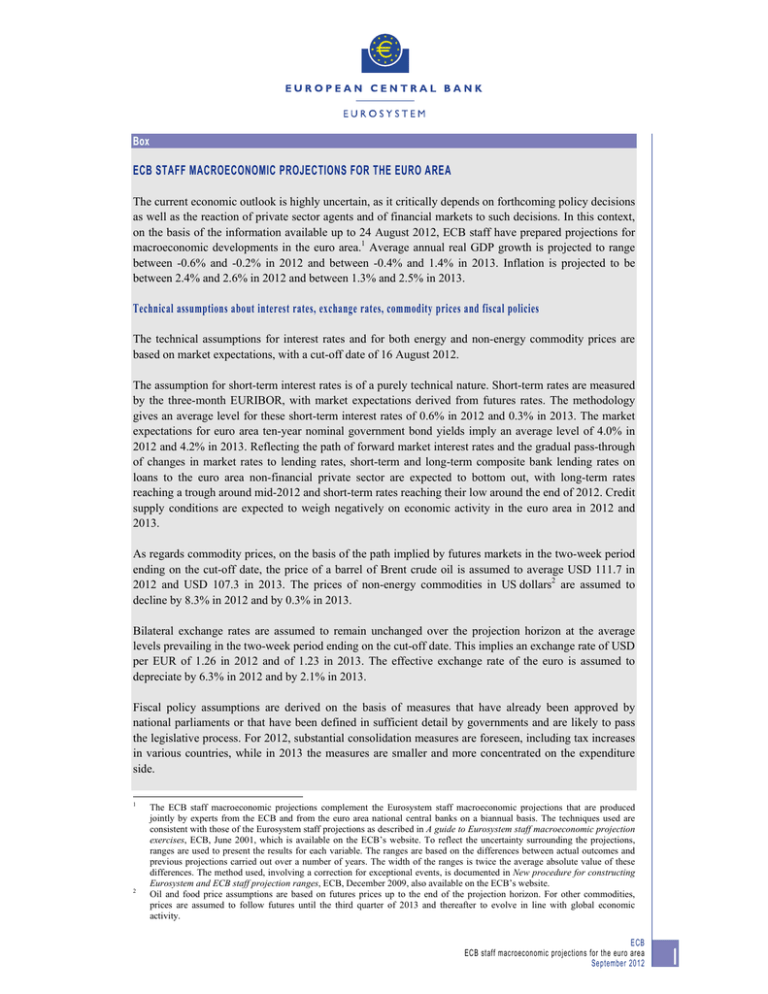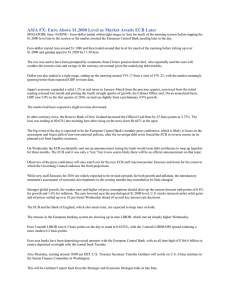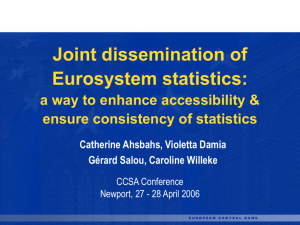
Box
ECB STAFF MACROECONOMIC PROJECTIONS FOR THE EURO AREA
The current economic outlook is highly uncertain, as it critically depends on forthcoming policy decisions
as well as the reaction of private sector agents and of financial markets to such decisions. In this context,
on the basis of the information available up to 24 August 2012, ECB staff have prepared projections for
macroeconomic developments in the euro area.1 Average annual real GDP growth is projected to range
between -0.6% and -0.2% in 2012 and between -0.4% and 1.4% in 2013. Inflation is projected to be
between 2.4% and 2.6% in 2012 and between 1.3% and 2.5% in 2013.
Technical assumptions about interest rates, exchange rates, commodity prices and fiscal policies
The technical assumptions for interest rates and for both energy and non-energy commodity prices are
based on market expectations, with a cut-off date of 16 August 2012.
The assumption for short-term interest rates is of a purely technical nature. Short-term rates are measured
by the three-month EURIBOR, with market expectations derived from futures rates. The methodology
gives an average level for these short-term interest rates of 0.6% in 2012 and 0.3% in 2013. The market
expectations for euro area ten-year nominal government bond yields imply an average level of 4.0% in
2012 and 4.2% in 2013. Reflecting the path of forward market interest rates and the gradual pass-through
of changes in market rates to lending rates, short-term and long-term composite bank lending rates on
loans to the euro area non-financial private sector are expected to bottom out, with long-term rates
reaching a trough around mid-2012 and short-term rates reaching their low around the end of 2012. Credit
supply conditions are expected to weigh negatively on economic activity in the euro area in 2012 and
2013.
As regards commodity prices, on the basis of the path implied by futures markets in the two-week period
ending on the cut-off date, the price of a barrel of Brent crude oil is assumed to average USD 111.7 in
2012 and USD 107.3 in 2013. The prices of non-energy commodities in US dollars2 are assumed to
decline by 8.3% in 2012 and by 0.3% in 2013.
Bilateral exchange rates are assumed to remain unchanged over the projection horizon at the average
levels prevailing in the two-week period ending on the cut-off date. This implies an exchange rate of USD
per EUR of 1.26 in 2012 and of 1.23 in 2013. The effective exchange rate of the euro is assumed to
depreciate by 6.3% in 2012 and by 2.1% in 2013.
Fiscal policy assumptions are derived on the basis of measures that have already been approved by
national parliaments or that have been defined in sufficient detail by governments and are likely to pass
the legislative process. For 2012, substantial consolidation measures are foreseen, including tax increases
in various countries, while in 2013 the measures are smaller and more concentrated on the expenditure
side.
1
2
The ECB staff macroeconomic projections complement the Eurosystem staff macroeconomic projections that are produced
jointly by experts from the ECB and from the euro area national central banks on a biannual basis. The techniques used are
consistent with those of the Eurosystem staff projections as described in A guide to Eurosystem staff macroeconomic projection
exercises, ECB, June 2001, which is available on the ECB’s website. To reflect the uncertainty surrounding the projections,
ranges are used to present the results for each variable. The ranges are based on the differences between actual outcomes and
previous projections carried out over a number of years. The width of the ranges is twice the average absolute value of these
differences. The method used, involving a correction for exceptional events, is documented in New procedure for constructing
Eurosystem and ECB staff projection ranges, ECB, December 2009, also available on the ECB’s website.
Oil and food price assumptions are based on futures prices up to the end of the projection horizon. For other commodities,
prices are assumed to follow futures until the third quarter of 2013 and thereafter to evolve in line with global economic
activity.
ECB
ECB staff macroeconomic projections for the euro area
September 2012
1
Assumptions with regard to the international environment
World real GDP growth (excluding the euro area) is projected to pick up from 3.8% in 2012 to 4.0% in
2013. Although the recent releases of real GDP growth data for the second quarter of 2012 confirmed a
fairly synchronised moderation in global growth momentum, a gradual pick-up in global growth starting
in the course of the second half of 2012 is expected, supported by improving financial conditions, in an
environment of accommodative monetary policies. However, the pace of growth in major advanced
economies is expected to be dampened by weaknesses in the labour and housing markets of those
economies, as well as the need to further repair both public and private sector balance sheets. In emerging
markets, growth has moderated recently but remains solid, thereby making an important contribution to
global economic activity. Euro area foreign demand is expected to grow by 4.2% in 2012 and 5.8% in
2013.
Real GDP growth projections
Real GDP declined by 0.2% in the second quarter of 2012, following a stagnation in the previous quarter.
The ongoing and persistent weakness of activity, which started in the spring of 2011, largely reflects the
fragility of domestic demand, which more than outweighs positive external contributions to growth. In the
second half of 2012 real GDP is projected to decline slightly, as the adverse impact of high commodity
prices, a tightening in the fiscal stance, low consumer and business confidence and adverse credit supply
conditions in some countries continues to affect activity. Looking ahead, real GDP growth is expected to
gradually gain momentum during the course of 2013. Initially, an improving external environment and
enhanced competitiveness are projected to support exports. The recovery is also likely to be supported by
the favourable impact of the very low level of short-term interest rates on private demand and by the
effects on real disposable income of the assumed decline in energy and food price inflation. Moreover,
measures to restore the functioning of the financial system should also support domestic demand.
However, ongoing balance sheet restructuring and adverse financial conditions in some euro area
countries are likely to continue to dampen the projected recovery over the forecast horizon. Overall, the
projected recovery is expected to remain muted by historical standards, resulting in a negative output gap
over the whole projection horizon. In annual terms, real GDP is expected to grow by between -0.6% and 0.2% in 2012 and between -0.4% and 1.4% in 2013.
Considering the demand components in more detail, extra-euro area export growth is projected to gain
momentum during the second half of 2012 and to pick up further thereafter, reflecting the gradual
strengthening of euro area foreign demand as well as gains in export price competitiveness. Business
investment is expected to decline during the remainder of 2012, owing to the heightened uncertainty and
weak sentiment, as well as to adverse credit supply conditions in some countries. It should pick up again
in 2013, supported by the strengthening in domestic and external demand, the very low level of interest
rates, expectations of lower cost pressures and improving profit mark-ups. Residential investment is
expected to decline in the near term, before recovering modestly from late 2012 onwards. The need for
further adjustment to correct past excesses in the housing markets of some countries is expected to
continue to weigh on residential investment. However, these adverse effects should be offset, albeit only
partially, by the enhanced relative attractiveness of housing investment in some other countries, in which
residential investment is supported markedly by historically low mortgage rates. Government investment
is expected to decline throughout the projection horizon, owing to the fiscal consolidation packages in
several euro area countries.
Private consumption is projected to decline throughout 2012, reflecting a fall in real disposable income,
owing to a decrease in both employment and real compensation per employee, fiscal consolidation
measures and weak non-labour income. A decline in the savings ratio, as households try to smooth
consumption over time, should partially compensate for the fall in real disposable income. However, the
2
ECB
ECB staff macroeconomic projections for the euro area
September 2012
drop in the savings ratio is expected to be moderated by the persistent rise in the unemployment rate and
weak consumer sentiment, which are likely to increase precautionary savings. Private consumption is
expected to increase modestly during the course of 2013, reflecting the recovery of real disposable
income as the adverse impact of the above factors gradually fades and a decline in commodity price
pressures benefits real incomes. Government consumption is projected to decline in 2012 and 2013,
owing to fiscal consolidation efforts.
Following a decline in the first half of 2012, extra-euro area imports are expected to increase again in the
second half of the year and to gain further momentum thereafter, albeit still constrained by weak total
demand. Reflecting stronger growth in exports, net trade is expected to make a significant positive
contribution to GDP growth over the whole projection horizon. The current account, which was balanced
in 2011, is expected to register a widening surplus over the projection horizon owing to an increasing
trade surplus.
Table A Macroeconomic projections for the euro area
(average annual percentage changes)1)
2011
2012
2013
HICP
2.7
2.4 – 2.6
1.3 – 2.5
Real GDP
Private consumption
Government consumption
Gross fixed capital formation
Exports (goods and services)
Imports (goods and services)
1.5
0.2
-0.3
1.5
6.4
4.2
-0.6 – -0.2
-1.1 – -0.7
-0.8 – -0.2
-4.1 – -2.5
1.8 – 4.4
-1.3 – 1.3
-0.4 – 1.4
-0.8 – 0.8
-0.8 – 0.4
-1.7 – 2.7
1.1 – 8.1
0.3 – 7.1
1) The projections for real GDP and its components refer to working day-adjusted data. The projections for imports and exports
include intra-euro area trade.
Price and cost projections
The headline inflation rate, which in August stood at 2.6%, is expected to remain above the 2% mark
throughout 2012, owing to high energy prices, the depreciation of the euro and increases in indirect taxes
in some countries. It is expected to average between 2.4% and 2.6% in 2012. In 2013 the inflation rate is
expected to decline to between 1.3% and 2.5%, largely driven by developments in energy price inflation,
which is foreseen to ease substantially over the projection horizon, reflecting the assumed gradual decline
in oil prices. Food price inflation is also expected to decrease in 2013. HICP inflation excluding food and
energy is expected to remain broadly stable over the projection horizon. Upward pressures related to the
recent depreciation of the euro and increases in indirect taxes and administered prices in some countries
are expected to be broadly offset by downward pressures stemming from an environment of weak
domestic demand and high unemployment.
In more detail, external price pressures, driven upwards in the past by rising oil prices and the
depreciation of the euro, are expected to ease over the projection horizon. In particular, the assumptions
of a stabilisation of the euro exchange rate and of a decline in oil prices imply that the annual growth rate
of the import deflator should decline gradually. With regard to domestic price pressures, the annual
growth rate of compensation per employee is expected to decline in 2012 and to remain subdued in 2013,
reflecting the deteriorating situation in the labour market and fiscal consolidation measures in some
ECB
ECB staff macroeconomic projections for the euro area
September 2012
3
countries. Since wages are expected to grow less than prices in 2012, real compensation per employee is
projected to fall in that year before stabilising in 2013, remaining, however, well below the pace of
productivity growth. Growth in unit labour costs is projected to pick up in 2012 and to decline in 2013,
mostly owing to productivity developments. The profit margin indicator is expected to fall in 2012,
buffering the increasing unit labour costs in an environment of weak demand. Thereafter, decelerating
unit labour costs and improving economic conditions are expected to support the recovery in profit
margins. As part of fiscal consolidation plans, increases in administered prices and indirect taxes are
expected to make a large contribution to HICP inflation in 2012 and in 2013.
Comparison with the June 2012 projections
Compared with the Eurosystem staff macroeconomic projections published in the June 2012 issue of the
Monthly Bulletin, the ranges for real GDP growth in the euro area for 2012 and 2013 have been revised
downwards. Most of the downward revisions concern the last two quarters of 2012, implying a negative
statistical carry-over into 2013. With regard to HICP inflation, the projection ranges for 2012 and 2013
are somewhat higher than in the June 2012 projections, mainly reflecting the impact of the weaker
exchange rate of the euro.
Table B Comparison with the June 2012 projections
(average annual percentage changes)
2012
2013
Real GDP – June 2012
Real GDP – September 2012
-0.5 – 0.3
-0.6- -0.2
0.0 – 2.0
-0.4 – 1.4
HICP – June 2012
HICP – September 2012
2.3 – 2.5
2.4 – 2.6
1.0 – 2.2
1.3 – 2.5
Comparison with forecasts by other institutions
A number of forecasts for the euro area are available from both international organisations and private
sector institutions (see Table C). However, these forecasts are not strictly comparable with one another or
with the ECB staff macroeconomic projections, as they were finalised at different points in time.
Additionally, they use different (partly unspecified) methods to derive assumptions for fiscal, financial
and external variables, including oil and other commodity prices. Finally, there are differences in working
day adjustment methods across different forecasts.
According to the forecasts currently available from other organisations and institutions, euro area real
GDP growth is expected to range between -0.5% and -0.1% in 2012, which is close to the range of the
ECB staff projections. For 2013, available forecasts lie between 0.3% and 1.0%, which is within the range
of the ECB staff projections. As regards inflation, available forecasts suggest that the average annual
HICP inflation rate will be in a range between 2.0% and 2.4% in 2012, which is below the range of the
ECB staff projections. For 2013, available forecasts suggest that HICP inflation will be in a range
between 1.6% and 1.9%, which is within the range of the ECB staff projections.
4
ECB
ECB staff macroeconomic projections for the euro area
September 2012
Table C Comparison of forecasts for euro area real GDP growth and HICP inflation
(average annual percentage changes)
Date of release
GDP growth
HICP inflation
2012
2013
2012
2013
OECD
May 2012
-0.1
0.9
2.4
1.9
European Commission
May 2012
-0.3
1.0
2.4
1.8
IMF
July 2012
-0.3
0.7
2.0
1.6
Survey of Professional Forecasters
August 2012
-0.3
0.6
2.3
1.7
Consensus Economics Forecasts
August 2012
-0.5
0.3
2.3
1.7
Euro Zone Barometer
August 2012
-0.5
0.3
2.3
1.8
-0.4 – 1.4
2.4 – 2.6
1.3 – 2.5
ECB staff projections
September 2012 -0.6—0.2
Sources: European Commission Economic Forecast, Spring 2012; IMF World Economic Outlook Update, July 2012, for real GDP
growth and World Economic Outlook, April 2012, for inflation; OECD Economic Outlook, May 2012; Consensus Economics
Forecasts; MJEconomics; and the ECB’s Survey of Professional Forecasters.
Notes: The ECB staff macroeconomic projections and the OECD forecasts both report working day-adjusted annual growth rates,
whereas the European Commission and the IMF report annual growth rates that are not adjusted for the number of working days per
annum. Other forecasts do not specify whether they report working day-adjusted or non-working day-adjusted data.
© European Central Bank, 2012
Address: Kaiserstrasse 29, 60311 Frankfurt am Main, Germany
Postal address: Postfach 16 03 19, 60066 Frankfurt am Main, Germany
Telephone: +49 69 1344 0
Fax: +49 69 1344 6000
Website: http://www.ecb.europa.eu
All rights reserved.
Reproduction for educational and non-commercial purpose is permitted provided that the source is acknowledged.
ECB
ECB staff macroeconomic projections for the euro area
September 2012
5


